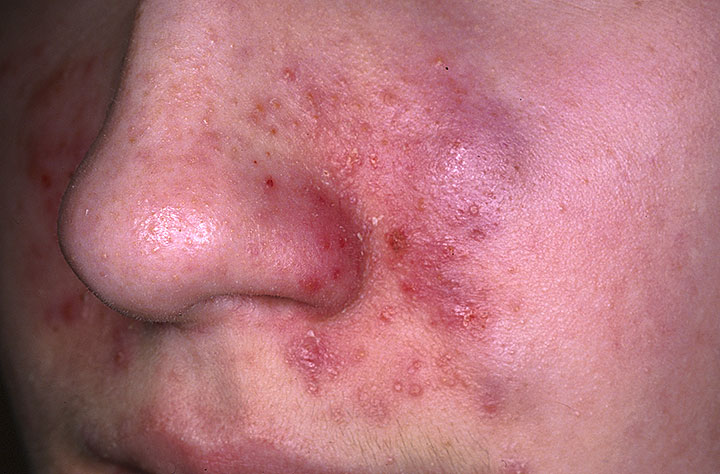DANDRUFF
(SEBORRHEIC DERMATITIS):
Seborrheic dermatitis is a common red, scaly, itchy rash that develops in areas of the skin rich in oil glands, such as the scalp, sides of the nose, eyebrows, ears, eyelids, and middle of the chest. Other areas, such as the navel (belly button), buttocks, underarms, breasts, and groin, may be involved.
Seborrheic dermatitis is chronic and relapsing, worsening during seasonal changes and at times of stress. It may be socially embarrassing, especially because of the scaling scalp, which may be perceived as uncleanliness.
WARTS:
These
small growths are caused by a germ (virus) and can be transmitted
from one person to another. Also, scratching a wart
and
then putting the same finger on another part of the
body can transfer the disease to that body part as well. These warts
can be easily treated by burning with extreme heat or cold using
special devices in your skin specialist�s clinic. Self medication by
burning them with acids or picking at them can leave unsightly marks
and even spread the disease.
HEAD
LICE:
Head lice can cause severe itching in the head and
is an extremely common problem in school going children. If commonly
available remedies like combing hair with a very fine comb after
shampooing with anti-lice shampoo do not work, a dermatologist may
be consulted.
SLIGHTLY WHITE SPOTS ON
THE FACE (PITYRIASIS ALBA):
These light colored spots
are NOT caused by Calcium deficiency. It is a form of eczema and can
be easily treated by your skin specialist. Avoiding the sun
following the treatment may help lighten the surrounding skin
thereby making the spots less visible during the recovery period. It
usually takes a few months to regain the color in these spots after
the treatment.
VITILIGO
(LEUKODERMA):
These markedly white spots are not caused
by drinking milk with fish. Sour food or Vitamin-C does not cause
leukoderma. These are the common myths spread by non qualified
medical practitioners. In fact every human being has an immune
system (body defense system) to fight off infections caused by
germs. Sometimes this defense system starts working against the
cells which produce the skin color. These cells are called
melanocytes (pronounced as MAY-LANO-SITE). In the beginning of the
disease, the defense system just paralyzes the melanocytes and they
stop making the color. At this stage they can be salvaged with the
proper treatment. If not treated early, the defense system can
permanently damage these cells, making the treatment difficult. The
treatment usually consists of medicated creams, treatment with
ultraviolet light in your dermatologist�s clinic, and sometimes oral
medications with ultraviolet light. If no improvement occurs, a
latest treatment called �Melanocyte Transplant� is now available in
Pakistan. In this treatment the color producing cells are
transferred from the normal skin to the white spots, where they
start producing the skin color.
UNEVEN TONE & DARK
SKIN:
This can be easily prevented by avoiding harsh sun
and staying in the shade. Different sun blocks with Sun Protection
Factor (SPF) of 35 or more and UVA UVB protection, along with
physical protection with clothing, hats and umbrellas can prevent
uneven skin tone. Remember, the intense and prolonged sun exposure
can darken the skin and make the skin older looking sooner. Normal
exposure to the sun is necessary for Vitamin-D production in the
body. So try to avoid the direct sun between 10 am and 4 pm when the
harmful rays of the sun are at their peak.